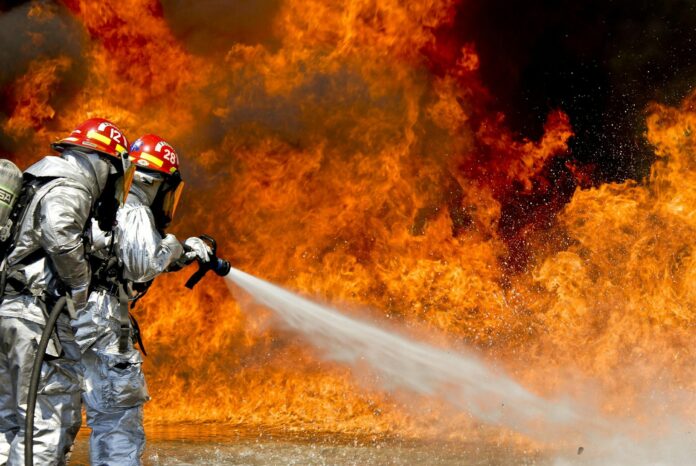
Firefighters are the unsung heroes of our society. These fearless individuals battle raging infernos to rescue trapped or injured people.
Their duty of extinguishing fires exposes them to a host of health issues. Those health issues don’t end with coughing, congestion, or stinging eyes but linger long after the flames have been extinguished.
Beyond the immediate dangers of physical injury and smoke inhalation, firefighters face a myriad of health hazards that can affect their well-being for years to come.
Here, we’ll discuss some common long-term health risks among firemen and share a few ways to avoid them.
3 Common Health Risks Among Firefighters
Here are three long-term health risks common among firefighters:
1. Cancer

Firefighters are three times more likely to die from certain types of cancers than the general population.
Rates of prostate cancer, esophageal cancer, and leukemia appear to be 3.8, 2.4, and 3.2 times higher than the norm. Exposure to toxic chemicals while battling blazes increases their risk of cancer. Many of these substances, such as benzene, asbestos, and arsenic, are suspected or known to cause cancer.
The toxic chemicals—per- and polyfluoroalkyl substances—in firefighting gear could also contribute to rising cancer cases.
These harmful chemicals are also present in aqueous film forming foam (AFFF), which is used to put out fuel-based fires. A recent study links AFFF with testicular cancer. Blood samples from 530 airmen with testicular cancer were analyzed, and they were found to have higher levels of PFOS – a type of PFOS – than 530 cancer-free military members.
A growing number of firefighters are filing AFFF lawsuits. In the AFFF firefighting foam lawsuit, firefighters claimed they were exposed to high quantities of PFAS and that firms knew the foams contained the toxic chemical, which can cause serious health issues. It also alleged that suppliers marketed their products as safe despite knowing the harms associated with them.
Some companies that supplied AFFF to fire departments, TorHoerman Law informs, are Chemguard Inc., Tyco Fire Products, Chemours, DuPont, and 3M. These, along with several other companies, are the defendants in AFFF lawsuits.
2. Cardiovascular Disease

Findings from a study conducted by Martin et al. discovered a remarkably high prevalence of cardiovascular disease risk factors among firemen.
Occupational stress related to emergency duty might elevate the risk of cardiovascular events in these individuals. Smoking, obesity, hypertension, sedentarism, and hypercholesterolemia could also contribute to cardiovascular disease in firefighters.
In 2022, about 45% of on-duty fatalities were caused by sudden cardiac death—many of these were related to cardiovascular disease while performing emergency duties.
The sudden bursts of intense exertion during emergency responses can lead to spikes in blood pressure and adrenaline levels, further exacerbating the risk of cardiovascular events like stroke and heart attacks. Prolonged exposure to heat and stress compounds these risks, which make firefighters more susceptible to hypertension and other cardiovascular conditions.
3. Hearing Loss

Recent research reveals that firemen are 19% more likely to suffer from hearing loss. Most firefighters are unaware of this risk.
About 30% of South Florida firefighters exhibited mild to profound hearing loss. Hearing loss among firefighters stems from exposure to high levels of noise while on the job.
The blaring sirens, equipment, and other noises at emergency scenes subject firefighters to sound levels exceeding safe limits, leading to gradual hearing impairment over time. Prolonged exposure to such noise damages the inner ear’s delicate structure, resulting in tinnitus or permanent hearing loss.
3 Ways Firefighters Can Avoid Long-Term Health Problems
Firefighters can take proactive measures to avoid long-term health problems by prioritizing their well-being both on and off duty. Here are some actionable tips:
1. Regular Health Screenings

Regular health screenings such as cancer screening, respiratory function tests, and cardiovascular assessments are important for firefighters. They can help detect potential health issues early before they escalate into more serious problems.
Early detection allows for timely intervention and management, significantly improving health outcomes and quality of life.
2. Proper PPE Usage
Wearing personal protective equipment (PPE) throughout the job is essential for firefighters to minimize exposure to several hazards while on duty. This includes wearing self-contained breathing apparatus (SCBA), turnout coats, gloves, and helmets when responding to fires or other emergencies.
Make sure to wear a properly-fitting PPE and a tight-fitting mask. This will prevent toxins from entering your body and reduce the risk of long-term health issues associated with exposure to hazardous substances and environments.
3. Stay Physically Fit

Firefighters are required to maintain physical fitness to meet the rigorous demands of their jobs. However, prioritizing physical fitness can also lower your risk of developing long-term health conditions, especially cardiovascular disease.
Exercises such as cardiovascular workouts and strength training will help maintain optimal fitness levels essential for the demands of firefighting. Consider performing them regularly. They will help reduce the risk of musculoskeletal injuries.
Additionally, eat a balanced diet to maintain a healthy body weight. Proper nutrition also supports cardiovascular health and reduces the risk of obesity-related conditions.
To wrap things up, the risks of firefighting extend beyond the immediate dangers of battling flames.
Long-term health risks such as cancer, cardiovascular disease, and hearing loss are some issues prevalent among firefighters. Musculoskeletal injuries, sleep disorders, post-traumatic stress disorder, and respiratory illnesses are also common among firefighters.
Certain proactive measures, such as proper usage of PPE, staying physically fit, and regular health screenings, can mitigate these risks.








